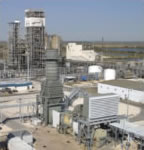
![]()
 |
| TECO's 260MW Polk County Power Station uses a state-of-the-art integrated coal gasification combined-cycle technology to product both electricity and hydrogen (Photo: Tampa Electric Co.) |
|---|
The electrolytic process splits water into its two basic components of hydrogen and oxygen. Electrolysis involves passing an electric current through water. The current enters the electrolysis device through the cathode (a negatively charged electrode), passes through the water, and leaves through an anode (a positively charged electrode). Hydrogen is evolved and collected at the cathode and oxygen is generated and collected at the anode.
Limited quantities of hydrogen are currently produced from electrolysis, since electrolytic hydrogen is relatively expensive, with approximately 80 percent of the operating cost being the cost of electricity. Electrolysis is economically feasible for uses requiring small amounts of hydrogen, extremely pure hydrogen or when power costs are low. The need for very pure hydrogen is for use in the pharmaceutical, electronics, the food industries or other special applications.
Hydrogen can also be obtained from water by other methods such as solar that are not currently available for large-scale production. These methods are the target of research and development activities (See solar hydrogen production).
